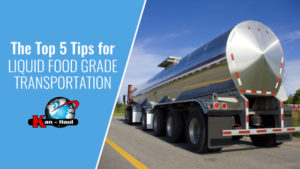August 19, 2021
The Top 5 Tips for Liquid Food Grade Transportation

If you are a food-grade liquid distributor or supplier, reliable transportation is a peak concern. So, you need to hire a trusted third party who ensures the safe conditions of your items. Read ahead to learn the best practices for improving product transportation across your supply chain.
Tips for Improving Liquid Food Grade Transportation
Foods are among the most challenging bulk items to transport. You must ensure proper storage and timely delivery to avoid spillage and spoilage.
Do you know the average cost of a recall to food companies is $10 million? The figure accounts for brand image damages, lost sales, and related direct recall costs. You can prevent such losses by employing these tips for improving bulk food grade transportation.
Know What You are Shipping
You need a Safety Data Sheet (SDS) that contains information about your product’s characteristics.
Spoilage rate is one of these essential characteristics. The data helps you and your carrier understand how long the item can remain in a tank without spoiling. Many carriers need extra time for an unexpected storm, blown tire, or other circumstances.
The SDS sheet also has information about compatibility with other products. This helps prevent contamination and ensures product integrity.
Choose the Right Container
Containerization history dates to the twentieth century when the first large steel boxes revolutionized global trade. These boxes still carry the clothes, shoes, and food you eat. However, transporting a large volume of food-grade liquid requires a special shipping container.
Select a shipping container that meets your requirements and remember to account for volume. Popular liquid food grade transport options include:
- Refrigerated shipping – Temperature-controlled transportation ideal for long hauls. The vehicle has a built-in refrigeration system that keeps your products at the desired temperature throughout the transportation process.
- Flexitank shipping – Shipping equipment manufactured from plastic. Flexitanks are suitable for moisture- and oxygen-sensitive products such as flat beer and wine, especially when they have barrier coats. They help maximize payload due to low equipment weight and protect your liquid cargo from contamination
- Iso-Tank shipping – Ideal for transporting a large capacity of liquid cargo. Anti-corrosive materials ensure the protection of your liquid while a strong steel structure ensures long life.
Use Monitoring Tools
Connected devices help track status updates and delivery details of liquid food products. Harness big data and machine learning (ML) technologies to gain real-time insight into transport information and resolve issues faster.
Examples include hiring transporters who install IoT-enabled technology and sensors in their trucks for:
- Tracking items
- Monitoring temperature
- Checking humidity conditions in the transport vehicle
Information from these tools will help decision-makers pinpoint a safety concern quickly before contamination of food-grade liquids. The tools are also effective solutions to reduce risk and get a full overview of your product transport data.
Maintain a Constant Temperature
A good deal of food-grade liquids are susceptible to temperature changes. Maintaining a constant temperature is easy for a customer who puts a water bottle in the refrigerator. It is more challenging when you are transporting a full tank across the country.
You need a transport solution that helps keep the liquid bulk items at the right temperature. Some systems circulate antifreeze around the outside of the tank to keep liquid from cooling off too fast. The tanks have piping that draws antifreeze from the vehicle’s radiator to prevent that from happening.
Insulated tanks may also have steam coils. They are plugged into a steam source when the vehicle is parked, this circulates steam around a tank and keeps it at an optimal temperature.
Carry Out Regular Audits
An audit allows you to streamline activities and processes and ensures that all participants comply with regulations and standards. Perform regular audits and maintain an audit trail to protect your business and avoid food contamination.
Auditors also review the processes, technologies, activities, and parties involved in the supply chain. This audit lets you see where improvements should be made.
Some things an audit should address include:
- Real-time tracking from shipment to delivery
- The participant’s capacity to prevent a safety concern before it becomes a problem
- Capacity to pinpoint logistics issues and resolve them in real-time
- Whether you have faith in your supplier’s tank washing capabilities to prevent product contamination and failed inspections
Get Effective Food Grade Liquid Transportation Services Today
Environmental concerns and food safety standards set by the FDA also make transporting food-grade liquid complicated. It is time you talk to bulk liquid transport experts. They will help keep food-grade liquid safe, ensure everything gets there in time, and reduce transportation costs.
Kan-Haul has over 30 years in bulk transportation of food-grade and other non-hazardous liquids. Contact our team and explore the liquid food-grade transportation options we have for you.
